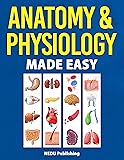Anatomy & Physiology Made Easy: An Illustrated Study Guide for Students To Easily Learn Anatomy and Physiology
amazon.com
Anatomy & Physiology Made Easy: An Illustrated Study Guide for Students To Easily Learn Anatomy and Physiology

Your cardiovascular system consists of the heart as the major blood pump, plus the thousands of miles of blood vessels inside your body. Blood must get to every living cell for your body to survive. The heart is an amazing organ that both receives and sends blood to where it’s needed in an efficient and coordinated process. Blood vessels carry
... See moreSummary of the importance of heart and blood circulation. Why exercise is important
There are certain growth factors in the system that tell the bone marrow to make or not make different types of cells. In the case of erythrocytes, or red blood cells, a hormone called erythropoietin is made by the kidneys as a growth factor hormone used to trigger red blood cell formation. There are similar growth factors, such as granulocyte
... See morethe ability to divide rapidly and differentiate into any cell in the bloodstream. All the blood components come from the same basic hematopoietic stem cell, or progenitor cell.
All blood cell types are made from hematopoietic stem cells, which are basically very immature baby cells in the bone marrow with a lot of potential. By themselves, they have no real function except that they have
remember past infections. There are B lymphocytes that mainly make antibodies and T lymphocytes that mainly destroy infected or cancerous cells in the body.
Lymphocytes: These are fairly abundant agranulocytes, representing about 20 to 30 percent of the total number of leukocytes. They will exit and enter the tissues whenever necessary, and last for different lifespans. These are very important in both making antibodies, helping the immune response in general, destroying infected cells, and acting as
... See moreYour blood type defines which antigens are located on the red blood cell surfaces. You receive half of these antigen types from your mother and half from your father.
blood is not as brightly colored as arterial blood.